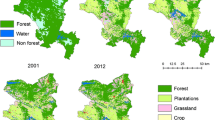Abstract
Forests are one of the most important components on our planet as they regulate a number of natural systems viz. the food chain, the water cycle, the carbon cycle etc. In this study, we have focused on the forest cover of districts that has a very small percentage of area covered by forests. The study has been performed for a time period of 30 years i.e. from 1990 to 2020 and a time series analysis of the changes in forest cover has been done. The forested areas are divided into three type namely very dense forest, moderately dense forest and open forest. Five districts in the state of West Bengal have been selected namely Hooghly, Nadia, Purba and Paschim Bardhhaman (considered together as Burdwan) and Purulia. These districts particularly belong to the South Bengal region and out of them namely Hooghly, Nadia and Bardhhaman are also a part of deltaic region of the Lower Ganga which is known as the Bhagirathi-Hooghly River in West Bengal. These districts are chosen because they are one of the most populous districts both in the state and also in the country but they lack adequate amount of natural vegetation cover, the reasons for which can be cited are the availability of fertile land for agriculture which consequently makes these places one of the most suitable areas for human beings to survive and thrive. In this study a standardised and simple index namely the Normalized Difference Vegetation Index (NDVI) has been used to delineate various kinds of forest and a Land Use Land Cover (LULC) classification has been done to study the present land use condition of these districts. It has been found that the district of Purulia has the maximum forest cover while the district of Hooghly lacks areas with very dense forest. Studies have shown that forest cover conditions has improved for all of these districts since the last decade but most of these improvements has been observed in the open forest category which signifies that social forestry might have been taking place which proves an increasing concern among people and the government in saving the environment.
Access this chapter
Tax calculation will be finalised at checkout
Purchases are for personal use only
Similar content being viewed by others
References
Bera S, Prakash A (2018) Forest cover change analysis based on remote sensing & GIS of West Singhbhum District, Jharkhand. Int J Res Appl Sci Eng Technol 6(5):1039–1050
Bhatta B (2017) Remote sensing and GIS. Oxford University Press, New Delhi, pp 375–376
Landis JR, Koch GG (1977) The measurement of observer agreement for categorical data. Biometrics 33(1):159–174
McHugh ML (2012) Interrater reliability: the kappa statistic. Biochem Med 22(3):276–282
Rawat JS, Kumar M (2015) Monitoring land use/land cover change using remote sensing and GIS techniques: a case study of Hawalbagh block, district Almora, Uttarakhand, India. Egypt J Remote Sens Space Sci 18:77–84 (National Authority of Remote Sensing and Space Sciences, Elsevier)
Rawat JS, Biswas V, Kumar M (2013) Monitoring land use/land cover change using remote sensing and GIS techniques: a case study of Ramnagar town area, district Nainital, Uttarakhand, India. Egypt J Remote Sens Space Sci 16:111–117 (National Authority of Remote Sensing and Space Sciences, Elsevier)
Rwanga S, Ndambuki JM (2017) Accuracy assessment of land use land cover classification using remote sensing and GIS. Int J Geosci 8:611–622 (Scientific Research Publishing)
Sahana M, Sajjad H, Ahmed R (2015) Assessing spatio-temporal health of forest cover using forest canopy density model and forest fragmentation approach in Sundarban reserve forest, India. Model Earth Syst Environ 1(49):1–10 (Springer)
Sonawane K, Bhagat V (2017) Improved change detection of forest using Landsat TM and ETM+ data. Remote Sens Land 18–40 (Gatha Cognition)
Acknowledgements
The authors are thankful to National Aeronautics and Space Administration (NASA) and the United States Geological Survey (USGS) for providing Landsat satellite imageries for free and helping them in all possible during the processing of these imageries. They also express their gratitude to European Space Agency (ESA) for providing the high resolution Sentinel 2 data for open access use.
Author information
Authors and Affiliations
Corresponding author
Editor information
Editors and Affiliations
Rights and permissions
Copyright information
© 2021 The Editor(s) (if applicable) and The Author(s), under exclusive license to Springer Nature Switzerland AG
About this chapter
Cite this chapter
Chatterjee, M., Dutta, A.D. (2021). Comparative Assessments of Forest Cover Change in Some Districts of West Bengal, India using Geospatial Techniques. In: Shit, P.K., Pourghasemi, H.R., Das, P., Bhunia, G.S. (eds) Spatial Modeling in Forest Resources Management . Environmental Science and Engineering. Springer, Cham. https://doi.org/10.1007/978-3-030-56542-8_8
Download citation
DOI: https://doi.org/10.1007/978-3-030-56542-8_8
Published:
Publisher Name: Springer, Cham
Print ISBN: 978-3-030-56541-1
Online ISBN: 978-3-030-56542-8
eBook Packages: Earth and Environmental ScienceEarth and Environmental Science (R0)




